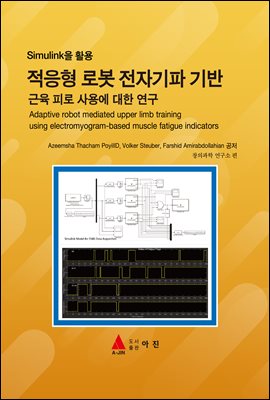
SIMULINK을 활용 적응형 로봇 전자기파 기반 근육 피로 사용에 대한 연구
- 저자Azeemsha Thacham PoyilID, Volker Steuber, Farshid Amirabdollahian 저
- 출판사아진
- 출판일2020-07-14
- 등록일2020-12-21
- SNS공유


- 파일포맷PDF
- 파일크기16MB
- 공급사YES24
-
지원기기
PC
PHONE
TABLET
프로그램 수동설치
전자책 프로그램 수동설치 안내
아이폰, 아이패드, 안드로이드폰, 태블릿,
보유 1, 대출 0,
예약 0, 누적대출 8, 누적예약 0
책소개
Studies on improving the adaptability of upper limb rehabilitation training do not oftenconsider the implications of muscle fatigue sufficiently. In this study, electromyogram
features were used as fatigue indicators in the context of human-robot interaction. They
were utilised for auto-adaptation of the task difficulty, which resulted in a prolonged
training interaction. The electromyogram data was collected from three gross-muscles of
the upper limb in 30 healthy participants. The experiment followed a protocol for
increasing the muscle strength by progressive strength training, that was an
implementation of a known method in sports science for muscle training, in a new domain
of robotic adaptation in muscle training. The study also compared how the participants in
three experimental conditions perceived the change in task difficulty levels. One task
benefitted from robotic adaptation (Intervention group) where the robot adjusted the task
difficulty. The other two tasks were control groups 1 and 2. There was no difficulty
adjustment at all in Control 1 group and the difficulty was adjusted manually in Control 2
group. The results indicated that the participants could perform a prolonged progressive
strength training exercise with more repetitions with the help of a fatigue-based robotic
adaptation, compared to the training interactions, which were based on manual/no
adaptation. This study showed that it is possible to alter the level of the challenge using
fatigue indicators, and thus, increase the interaction time. The results of the study are
expected to be extended to stroke patients in the future by utilising the potential for
adapting the training difficulty according to the patient’s muscular state, and also to
have a large number repetitions in a robot-assisted training environment.
목차
제 1편 : SIMULINK 기본편1.1 SIMULINK의 시작 1
블록의 연결 5
블록 파라미터의 설정 7
시뮬레이션 파라미터 (Configuration Parameters)의 설정 8
시뮬레이션의 수행 9
블록 파라미터의 표시 9
복수 데이터의 표시 11
2.2 동적 시뮬레이션 13
이차 미분방정식 17
선형 상태변수 모델 23
DC 모터의 시뮬레이션 24
함수 블록의 사용 29
차분방정식(difference equation)의 모델링 34
Subsystem(부시스템)의 구성 37
제 2편 : 연구논문
Adaptive robot mediated upper limb training using
electromyogram-based muscle fatigue indicators
1. Introduction 41
2. Materials and methods 44
3. Experimental protocol and methods 45
4. Robotic resistance adaptation 56
5. Task performance measures 59
6. Experimental Results 57
7. Conclusions 69
8. References 70

















